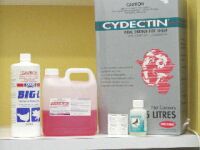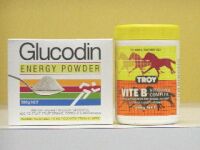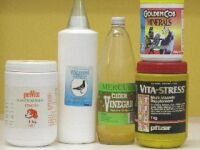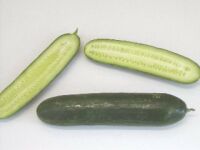|
'Basic' Finch Maintenance!!
In this short article I propose to look at a number of
possible problem
areas that you might encounter when keeping and breeding your finches.
Namely developing a realistic and effective Quarantine Program.
QUARANTINE - Let's see if this scenario rings a bell with you. You've
just
dropped in for a 'look' at your local bird shop - just in case they have
that
elusive mate for those single finches of yours! There she is (no sexism
implied here, but chances are it IS a hen you're looking for!!) a perfect specimen,
tight feathered and 'healthy'. Home she goes and that niggling voice in your
head starts up! "Look at her, she's perfect. Go on, put her straight in with
your male - look, he hasn't seen a female for 8 months so imagine how keen
they'll be to breed." So, labouring under this intense mental torment you
succumb and take your new purchase out into the aviary and release her.
They are quick to pair up and nesting commences on cue and then 'things' start to go wrong. Your new hen dies and the cock bird follows suit and
then
a number of other finches are looking ill and a few more 'unexplained'
deaths occur. Just a coincidence? "Hey, if you've got live finches you've got
dead
ones too, right?!!" Well maybe, but what if it WAS that bird that wasn't put
through your quarantine program that caused these deaths?
Regardless of what you believe to be the problem the next stop for some of
your deceased finches SHOULD/MUST be the avian veterinarian. OK, so you're not as stupid as our 'hypothetical birdman' and your new purchase goes
into
your isolation cage, what now? Firstly your isolation cage should be just
that
and not a holding flight with other occupants that have been in it for
various
periods of time.
So, here goes, a quarantine program that has been used and fine-tuned by us for a number of years. We are not vets and the medications and treatments
are ones that we use and, no doubt, people will disagree and have 'better
schemes and more effective drugs' and all I can say is write it down and
share it with all of us! Our quarantine lasts for at least 40 days and aims to
cover
most commoner internal and protozoal parasites as we have found that these
are the biggest killers of finches down here. I would imagine that some
fungal treatment would be prudent for the more tropical/humid areas of Australia.
|
 |
 |
| Wormers-a selection of those
about! |
Essentials- Glucodin & Vitamin B |
Day 1: Your birds arrive and are placed in isolation and over the next 4
days
you observe them and try to discern any obvious health problems… droopy
wings, soiled vents, 'fluffy appearance'………….
Any birds that exhibit these 'danger signs' are placed in a hospital cage
and
we administer antibiotics and send a fecal sample to an avian vet for
analysis.
These ill birds are placed on antibiotics for 8-10 days in order to reduce
the
creation of resistant strains of bacteria. If, like me, you know of people
that
give their birds antibiotics for 2-3 days or until 'they look better' then
steer
well clear of buying birds from them!!! Antibiotics are ONLY given to
obviously sick birds and NOT to all new arrivals. Remember that antibiotics don't
distinguish
between 'good and bad' bacteria so you can often create more problems than
you cure. (OK, a little simplistic, but you get the general idea!)
Just as an aside here, not all scours and dirty vents are a sign of severe
internal
disorders as many finches scour from the stress of being moved - the Diamond
Sparrow and members of the Longtail family in particular. Usually this
responds rapidly to electrolyte treatment BUT if it doesn't then you have a more
serious
problem.
 |
 |
| Recovery Cage with Red Lamp. |
Supplements- Calcium & Vitamins. |
During these four days the birds are given Vita-B powder (or an electrolyte
replacer) and glucodin in their water in order to offset the stress of
moving.
If you observe a finch under stress then you will notice that its droppings
are
very watery and, I feel, you need to use some form of electrolyte replacer
to
offset this before the finch looses too much of its body fluids. The Painted
Firetail is particularly prone to this excessive water loss and a Sydney
bird
dealer suggested that I put them on glucodin after moving them with
excellent results.
Throughout the quarantine period all birds are given Peppers quality finch
mix and greens n' grains plus a fine shell grit.
Change paper in cages and solution each day.
Day 5: If the birds are still looking sharp then they are placed on
BAYCOX at
the dose rate of 2mls/litre for 3 days- active ingredient 25g/litre
Toltrazuril.
This is an anticoccidial drug and the birds appear to take little notice of
the
drug in their water and will bathe in it!
This is the drug that is presently highly favoured among the poultry
fraternity and is, apparently, a superior treatment to the once popular Amprolium. If
you know the birds are coming from a wet/humid area then a treatment for
coccidia would seem to be essential.
Change paper in cages and solution each day.
Day 8: Three further days on Vita-B/Electrolyte Replacer and glucodin to
give birds a break between treatments.
Change paper in cages and solution each day.
Day 11: Onto the wormers. There are several types on the market and, no
doubt, everybody has their 'favourites' and some will think our choices are
'garbage', so be it!! The first choice is CYDECTIN, active ingredient
Moxidectin,
to treat for gizzard worm, roundworm and any internal mites. Since a vet
recommended this product we have been glowing in our praise of it. The
recommended dose is 5mls/litre for a 5-day period. Birds appear to vary in
their reaction to it but most will drink it unsweetened. You may suffer some
deaths about 2 days into treatment but, upon autopsy, you should find that
the bird died of worm impaction. This is in the case of heavy worm
infestation
where the wormer has killed the worms and they have formed a blockage in
the digestive system. More commonly seen in roundworm infestations in
parrot-like birds.
Change wormer solution and paper each day.
Day 16: A three-day break back onto the Vita-B/Electrolyte Replacer and
glucodin to give birds a further break before the next treatment.
Change paper in cages and solution each day.
Day 19: From roundworms we now turn our attention to protozoal parasites
that inhabit the digestive system. If your bird has been sent from an area
of
dubious water quality, a drought affected area or one that has been
subjected
to excessive flooding then you should make such a program a must. The
preferred drug (again by us!!) is Ronidazole. Ronivet-S (an antiprotozoal
drug
from the nitroimidasole group with Ronidazole at 60mg/litre) is used at a
dose
rate of 4grams/litre in the water for 7 days. This is effective against
motile
protozoa such as Trichomonas, Hexamita, Giardia, and Cochlosoma. At the
manufacturers prescribed dose rate the drug is effective in removing the
protozoans from the gut BUT if your birds are diagnosed by your vet with a
heavy infestation then a higher dose rate is essential. (This will be dealt
with
in detail in a future article.) For this we recommend a product called
TURBOSOLE
(Ronidazole at 100mg/litre), which is strong enough to also remove the
parasites that have embedded themselves in the gut wall.
Birds seem to show no aversion to this drug and will readily bathe in it -
our 'yardstick' for avian tolerance!! We have not found it necessary to
introduce
a sweetening agent with the Ronivet-S, but the Turbosole will require the
addition of a something to make it more palatable. Taste it, you will
get my gist- rapidly!
Day 26: Back to our by now well established recovery period of three
days
onto the Vita-B/Electrolyte Replacer and glucodin, again!!! After this stage
of
the quarantine I feel they probably REALLY look forward to these three days!
Change paper in cages and solution each day.
Day 29: Having rid your birds of most of its component of unwanted
guests we move onto a tapeworm treatment. We consider this stage of
quarantine to be essential as tapeworms are one of the biggest killers of
finches whether you live in Hobart or Cairns, Perth or Eden! For this we use
Prazivet at 5mls/litre (contains Praziquantel at 25mg/ml) and is given for
two days or else Avitrol Plus is given for one day. The advantage with
Avitrol Plus is that it also serves as a follow up treatment for roundworm
and gizzard worm as it contains Praziquantel at 2mg/ml and Levamisole
hydrochloride at 10mg/ml. The one draw back is that several finch species
appear to demonstrate a marked adverse reaction to Avitrol Plus. Having
witnessed this first hand on two separate occasions I can verify this
statement! However, if it is used following an initial treatment with
Cydectin there appears not to be any problems -so far at any rate! User
beware!
Change paper in cages and solution each day.
 Pictured is Lebanese Cucumber,
Pictured is Lebanese Cucumber,
a good source of vitaminC following period of
quarantine.
Days 31 - 40: If your birds have come through
their quarantine program without any problems these last few days can be used to prepare them for their
introduction into your aviary. In my 'neck of the woods'
we have cold winters and mild summers so I use these last few days to 'top
my birds up' with a Calcium/Vitamin D3 Syrup (from the Australian Pigeon
Company) to, hopefully, reduce the incidence of egg binding. This is water-soluble and is given at the rate of 10mls/litre for 2-3 days each week. This
product is also given to the finches in the aviaries. A number of people
administer some type of probotic solution to their birds during this period
but I have experienced several problems when using these so I no longer include it in my program.
Change paper in cages and solution each day.
Following the treatment of your new arrivals I would suggest that you wash
all cages, food/water bowls, perches.etc..with a hypochlorite or
chlorhexidine solution to remove any traces of the previous inhabitants. During
quarantine
I use plastic food dip bowls and coffee jar lids to supply food, water and
shellgrit and these are thrown away after the quarantine is complete - just
means you hope you have a lot of friends that eat dips and drink coffee! You
should also give some thought to a follow up worming treatment 14 days after
your initial dose to kill any eggs that may have hatched since you wormed
the birds.
Hopefully your birds will come through these treatments with
no ill effects and we have been using this regime for a number of years.
Given the number of products that are starting to filter
through to birdkeepers it should be relatively 'easy' to access all of the
drugs mentioned. Once again, these are what we use and there are a number of
alternative products on the market that I know other aviculturists use but I
suggest you check out all the products (yes, even the ones in this
article!!) before you administer them to your birds.
Unfortunately we are in the unenviable position of not having
a recognised bird vet in Hobart so we must try to 'cover all bases' when
importing new stock - as a post script to this we now are VERY lucky to have
Dr. James Harris arrive and put out his shingle at the Mayfair Veterinary
Clinic, 2 Russell Crescent, Sandy Bay. So the phrase "if you can't
diagnose/treat it yourself you may as well forget it!!" is now a thing of
the past! We look with envy upon mainlander's easy access to the likes of Dr
Colin Walker, Dr Pat Macwhirter and Dr. Rob Marshall for all our diagnosis
work must be done on the mainland and while we wait for results…well, you
can imagine the rest!
I am sure that many of you think I must be exaggerating so I
will relate a tale of our degree of service here. I rang a large Hobart
veterinarian clinic to arrange for a workmate to deliver a faeces sample for
analysis. When he did so it was still warm! I rang the following day to
receive the good/bad news to be told that: "It's sitting here in front of me
on the counter. I'll just get a vet to look at it." When I started gagging
on the phone and suggested it would be useless by now she retorted: "Anyway,
I don't know why you're getting so upset it was ONLY A FINCH!" Finch it may
have been but when I last looked I don't recall Himalayan Greenfinches being
exactly cheap!! Thanks to Dr. Harris I am sure that attitudes of this nature
will soon be a thing of the past!
If you have access to good bird vets then thank your lucky
stars because the money you spend there on autopsies and fecal smears will
allow you to develop a preventative regime that will save plenty of birds
'down the track'.
Perhaps the final word of warning is that there is little
point in having a fantastic quarantine program if you then forget to treat
your birds in the aviary on a regular follow up basis - especially where
your aviary is open to wild birds and animals.
| |
 |
|
| |
Antiprotozoal Drugs
& Antibiotics. |
|
NB. Although most of the drugs that are used during this
quarantine program are reputed NOT to affect the fertility of the treated
birds there may be some problems with breeding results immediately following
quarantine. For this reason it is advised that your birds be placed on some
of the many available products to 'build them up' before they are placed
into your breeding program.
Written by Marcus Pollard - Copyright remains with the author.
|




 Pictured is Lebanese Cucumber,
Pictured is Lebanese Cucumber, 